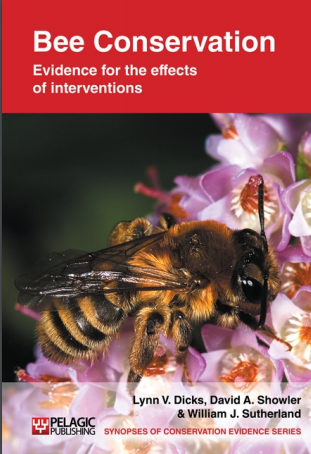Actions to conserve biodiversity
We have summarised evidence from the scientific literature about the effects of actions to conserve wildlife and ecosystems.
Review the evidence from the studies
Not sure what Actions are? Read a brief description.
Search for evidence
e.g. "frogs chytrid"
59 Actions found
Refine
Hide
59 Actions found
Download Actions
| 0 selected |
|
Order results by:
| Action | Effectiveness | Studies | Category | |
|---|---|---|---|---|
|
Plant dedicated floral resources on farmland Action Link |
Awaiting assessment | 17 |
|
|
|
Plant parks and gardens with appropriate flowers Action Link |
Awaiting assessment | 7 |
|
|
|
Practise wildlife gardening Action Link |
Awaiting assessment | 1 |
|
|
|
Prevent escape of commercial bumblebees from greenhouses Action Link |
Awaiting assessment | 2 |
|
|
|
Prevent spread of the small hive beetle Action Link |
Awaiting assessment | 1 |
|
|
|
Protect brownfield sites Action Link |
Awaiting assessment | 0 |
|
|
|
Protect existing natural or semi-natural habitat to prevent conversion to agriculture Action Link |
Awaiting assessment | 0 |
|
|
|
Provide artificial nest sites for bumblebees Action Link |
Awaiting assessment | 11 |
|
|
|
Provide artificial nest sites for solitary bees Action Link |
Awaiting assessment | 45 |
|
|
|
Provide grass strips at field margins for bees Action Link |
Awaiting assessment | 4 |
|
|
|
Provide nest boxes for stingless bees Action Link |
Awaiting assessment | 1 |
|
|
|
Provide set-aside areas in farmland Action Link |
Awaiting assessment | 2 |
|
|
|
Provide training to conservationists and land managers on bee ecology and conservation Action Link |
Awaiting assessment | 0 |
|
|
|
Raise awareness amongst the general public through campaigns and public information Action Link |
Awaiting assessment | 0 |
|
|
|
Re-plant native forest Action Link |
Awaiting assessment | 0 |
|
|
|
Rear and manage populations of solitary bees Action Link |
Awaiting assessment | 9 |
|
|
|
Rear declining bumblebees in captivity Action Link |
Awaiting assessment | 25 |
|
|
|
Reduce fertilizer run-off into margins Action Link |
Awaiting assessment | 0 |
|
|
|
Reduce grazing intensity on pastures Action Link |
Awaiting assessment | 1 |
|
|
|
Reduce pesticide or herbicide use generally Action Link |
Awaiting assessment | 1 |
|
|
|
Reduce the intensity of farmland meadow management Action Link |
Awaiting assessment | 4 |
|
|
|
Reduce tillage Action Link |
Awaiting assessment | 1 |
|
|
|
Reintroduce laboratory-reared bumblebee colonies to the wild Action Link |
Awaiting assessment | 8 |
|
|
|
Reintroduce laboratory-reared bumblebee queens to the wild Action Link |
Awaiting assessment | 0 |
|
|
|
Replace honey-hunting with apiculture Action Link |
Awaiting assessment | 6 |
|
Download Actions
| 0 selected |
|

Bee Conservation - Published 2010
Bee Synopsis
Watch this search
If you are familiar with RSS feeds, please click the button below to retrieve the feed URL:
RSS feed for this searchIf you are unfamiliar with RSS feeds, we would suggest reading this BBC article.
Unfortunately, due to the number of feeds we have available, we cannot provide e-mail updates. However, you could use tools such as Feed My Inbox to do this for you.
What are 'Individual studies' and 'Actions'?
Individual studies
An individual study is a summary of a specific scientific study, usually taken from a scientific journal, but also from other resources such as reports. It tells you the background context, the action(s) taken and their consequences.
If you want more detail please look at the original reference.
Actions
Each action page focuses on a particular action you could take to benefit wildlife or ecosystems.
It contains brief (150-200 word) descriptions of relevant studies (context, action(s) taken and their consequences) and one or more key messages.
Key messages show the extent and main conclusions of the available evidence. Using links within key messages, you can look at the paragraphs describing each study to get more detail. Each paragraph allows you to assess the quality of the evidence and how relevant it is to your situation.
Where we found no evidence, we have been unable to assess whether or not an intervention is effective or has any harmful impacts.





)_2023.JPG)














